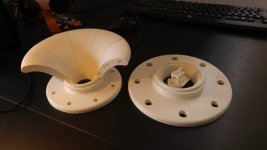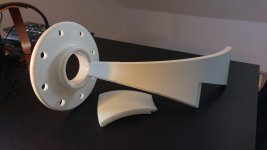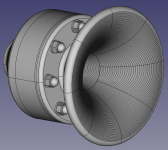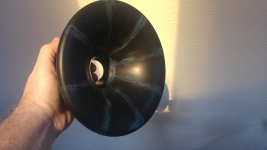If you do not need input, nor the 10 output channels of the Ultralite mk5, then go with the DM7. It has slightly better performance, but ONLY IF you are going to connect its balanced outputs to balanced inputs (e.g. on your amplifier(s)). If you plan to convert the balanced outputs to single ended RCA then I cannot recommend the DM7.
@CharlieLaub can you please tell me what balanced input amplifiers you are running? If diy are they built from a specific kit?
I don't have any myself, but those Neurochrome amps look pretty serious. Also, Topping's PA3s features balanced inputs. Big fan of the MA12070 chip used in that one
I have a bunch of different amps. For the past couple of years for a couple of systems I am using some install amps from Crestron. I get them used on Ebay, specifically the 3-ch AMP-3210T and 2-ch AMP-2210T (the HT variant is the same). Avoid the S variant since it only does 70V. These are well-built 1U size class-D amps pushing about 100W/ch at 8R and have auto-on. The connections are all via Phoenix terminal blocks so you have to make up the connection by modifying the interconnect. But they seem to sound OK and are very convenient to use. I also use some cheap power amps from Behringer to run subs, like the NX3000 that I did a fan mod on. I just bought a 4-channel Hypex based amp from BuckeyeAmps but I haven't put it into use yet. I also bought some TPA3255 amps from 3eAudio but I have not built them up yet. Oh and a couple of Crown CT-4150 too, but they are not currently in use. It's a bit of a mish-mash all around.@CharlieLaub can you please tell me what balanced input amplifiers you are running? If diy are they built from a specific kit?
Charlie,If you do not need input, nor the 10 output channels of the Ultralite mk5, then go with the DM7. It has slightly better performance, but ONLY IF you are going to connect its balanced outputs to balanced inputs (e.g. on your amplifier(s)). If you plan to convert the balanced outputs to single ended RCA then I cannot recommend the DM7.
How do you control the master volume on the Ultralite?. Is the volume control as seamless on the Ultralite as the IR remote on the DM7? I am using the DM7 for my 3-way active speakers, but I am missing a couple of analog inputs for the turntable.
I do volume control in software, not via the interface itself. You might have to write a softvol plug in ALSA and put it in your asoundrc file.
Do you have a phono pre-amp? What are you running your DM7 off? (a PC and DSP like Camilla? etc..)Charlie,
How do you control the master volume on the Ultralite?. Is the volume control as seamless on the Ultralite as the IR remote on the DM7? I am using the DM7 for my 3-way active speakers, but I am missing a couple of analog inputs for the turntable.
I am working with a Lenovo m90n-1 fan less PC, new with 3 year warranty, found online for 145. Having worked with RaspberryPI prior, I am impressed by what you get in the Lenovo package. Gave up on waiting for new Pi. Built for IOT, running Ubuntu Server with no problems. I see similar small form factor PCs refurbished in the range of 100. Have one installation running Volumio with output to a Hypex DLCP via USB. Very well built unit, mil-spec case, simple to run headless.Oh, another thing... I'd love to hear what mini PCs are recommended. Budget, say less than $300.
MN
Are you still interested in this project?thanks all. To be honest I'll wait until Raspberry Pis are available and will try to setup my ideas using CamillaDSP. Most likely using 4 Pis in parallel fed by the same I2S input data stream and giving I2S output data directly to a FDA connected to each Pi. The system should be synchronous because of the common I2S MCLK. I think this will be very versatile for testing. I'll give an update when there is any progress with building the horns itself 🙂
Raspberry Pis are available now. Initial sales after they were restocked have settled down so they're easily available again.
eg: https://thepihut.com/collections/raspberry-pi-boards
There is actually an 8 output Pi HAT, made by Audio Injector in Australia. I guess you would know this but it hasn't been mentioned in this thread. From measurements I've seen noise performance isn't great.
https://shop.audioinjector.net/detail/Sound_Cards/Octo+RCA+sound+card
Raspberry Pi i2s only really supports stereo output. As previously mentioned TDM is not supported but a hack is possible, done by manipulating the frame clock. This is interesting...
https://www.robertsonics.com/blog/2021/11/17/multi-channel-audio-for-the-raspberry-pi-part-1
Other products you might be interested in (once again you probably already know about them but you may not)...
Minidsp minidac8 (no longer available from minidsp, I suspect this is a rip-off)
https://www.aliexpress.com/item/32963391208.html?spm=a2g0o.productlist.main.3.4d8810fc0n9iCp&algo_pvid=7159463b-3e70-42d8-bcb8-149d46c97c72&algo_exp_id=7159463b-3e70-42d8-bcb8-149d46c97c72-1&pdp_npi=3@dis!GBP!240.99!108.45!!!300.00!!@211b88ef16908727076512763e1e23!66480390607!sea!GB!2770242570&curPageLogUid=hkrx59mnFCaI
Minidsp usbstreamer/ministreamer
https://www.aliexpress.com/item/1005001589344544.html?spm=a2g0o.cart.0.0.7d9938daBZjEo9&mp=1
My own opinion is that if I was going to do something like this I'd do it via a USB port, build a device with it's own regulated and filtered power supply with a nice clean 5v output circuit to power the RPi either via the Vin pins or the USB charging port. I'd put my device and the RPi side-by-side, try and screen the audio device with a metal box of some kind and have a plastic (acrylic?) lid for the Pi part, just so WiFi signals can get through, Pi's WiFi antenna is dodgy.
Maybe this, modified.
https://thepihut.com/products/deskpi-pro-v2-for-raspberry-pi-4
I'd say chaining four Raspberry Pis together is unnecessary complication and expense.
Last edited:
Thanks a lot for your reply and the many links provided. I'll go through these and reflect the solutions given.
Of course I'm still interested in the project. To be honest, the progress was not as fast as I hoped. I’m not sure whether I mentioned that the primary goal is to build an active horn loudspeaker system similar to Avantgarde’s Trio series, which I first heard in 1994. This is a dream of myself which I have now for 30 years. Buying these is not an option (200k euro). I tested different options like wood and styrofoam, but nothing gave the optical results I wished. Using 3d printing now seems to be the way to go.
I'm now at the point that I feel comfortable with starting to print the 6 horns soon. This is not as easy as one may think. On the one side it means more than 1500 hours printing time using nearly 30kg ABS filament using a modified consumer 3d printer. On the other side a lot of mechanical work to fit everything together, sand and polish it has to be done. I attached some images to give an idea of the first promising parts. Please note that the horns will be 20cm, 60cm and nearly 100cm in diameter. Only the 20cm and 60cm variants are shown.
My intention was to start building the signal processing “device” as soon as the 4 smaller horns are ready. Going this way enables measurements starting from 750Hz. If these results are okay I’ll implement the largest horns because these are the most complicated ones.
Using Rasperries + Camilla DSP is the way to go, of course. Most likely using a XMOS based USB interface is the best way to implement it. It leaves the decision open to use 4x I2S directly for independent I2S input fully digital Amps or converting it back to 4x TOSLINK and giving these signals to common TOSLINK input Amps using a common remote control to adjust the volume for all channels at once.
But still my first question is not answered for me. When using different Raspis with TOSLINK (Digi+ I/O) input output HATs and feeding the same TOSLINK signal to all, will these individual signal processing lines produce output signals with small timing errors (< 5° at highest crossover frequency of about 2500Hz) measured from Raspi to Raspi?! According to my understanding this should be the case. Because there is not a random delay in the input / output path (this would be the case when using different USB output devices). Perhaps somebody can help me answering this question. Even if this seems quite complicated it would make optical connections to each horn feasible and keep “analog” lines very short. I’m somehow fascinated by this idea.
Of course I'm still interested in the project. To be honest, the progress was not as fast as I hoped. I’m not sure whether I mentioned that the primary goal is to build an active horn loudspeaker system similar to Avantgarde’s Trio series, which I first heard in 1994. This is a dream of myself which I have now for 30 years. Buying these is not an option (200k euro). I tested different options like wood and styrofoam, but nothing gave the optical results I wished. Using 3d printing now seems to be the way to go.
I'm now at the point that I feel comfortable with starting to print the 6 horns soon. This is not as easy as one may think. On the one side it means more than 1500 hours printing time using nearly 30kg ABS filament using a modified consumer 3d printer. On the other side a lot of mechanical work to fit everything together, sand and polish it has to be done. I attached some images to give an idea of the first promising parts. Please note that the horns will be 20cm, 60cm and nearly 100cm in diameter. Only the 20cm and 60cm variants are shown.
My intention was to start building the signal processing “device” as soon as the 4 smaller horns are ready. Going this way enables measurements starting from 750Hz. If these results are okay I’ll implement the largest horns because these are the most complicated ones.
Using Rasperries + Camilla DSP is the way to go, of course. Most likely using a XMOS based USB interface is the best way to implement it. It leaves the decision open to use 4x I2S directly for independent I2S input fully digital Amps or converting it back to 4x TOSLINK and giving these signals to common TOSLINK input Amps using a common remote control to adjust the volume for all channels at once.
But still my first question is not answered for me. When using different Raspis with TOSLINK (Digi+ I/O) input output HATs and feeding the same TOSLINK signal to all, will these individual signal processing lines produce output signals with small timing errors (< 5° at highest crossover frequency of about 2500Hz) measured from Raspi to Raspi?! According to my understanding this should be the case. Because there is not a random delay in the input / output path (this would be the case when using different USB output devices). Perhaps somebody can help me answering this question. Even if this seems quite complicated it would make optical connections to each horn feasible and keep “analog” lines very short. I’m somehow fascinated by this idea.
Attachments
Perhaps you need to ask the real experts but I think it actually may be possible.
https://forums.raspberrypi.com/viewtopic.php?t=8496
https://forums.raspberrypi.com/viewtopic.php?t=8496
thanks. In deed, it is a dream to do this. And there is no plan B at the moment how to do it if this fails... Hopefully they will sound as they look. The Trio G3 does this of course 🙂Forgot to say, I hope you get those speakers right they look MAGNIFICENT!
Thanks for the advice to the Pi forum. I'll try this.
Are you open to using NLA 8.1 HAT DACS? If so - read on.
Charlie Laub (member on here) was looking to sell his boards:
http://www.suptronics.com/miniPCkits/x6000-7.1ch.html
The above provide I believe good distortion performance and channel separation. I have one myself.
Now to get TOSLINK - buy one of these:
https://www.aliexpress.com/item/100...!sea!NZ!122820545!&curPageLogUid=JBtrLNgSPTJZ

Then what you do on the Pi - is use ALSA with CamillaDSP and the snd_loop kernel module to create a loopback ALSA device. you can then use this config to route the TOSLINK of the USB5.1 through CamillaDSP (and whatever channel / crossover / EQ processing you need) then out to the Suptronix device (or any other USB multi-channel DAC).
Although the DAC in the USB5.1 soundcard is low quality, that should be of no concern if the TOSLINK input is used (as it stays in the digital domain). I'm not really conversant on the TOSLINK <-> USB protocol issues, so assume no loss of quality.
Let me know if you want more detail (e.g. CamillaDSP or Linux config).
Charlie Laub (member on here) was looking to sell his boards:
http://www.suptronics.com/miniPCkits/x6000-7.1ch.html
The above provide I believe good distortion performance and channel separation. I have one myself.
Now to get TOSLINK - buy one of these:
https://www.aliexpress.com/item/100...!sea!NZ!122820545!&curPageLogUid=JBtrLNgSPTJZ
Then what you do on the Pi - is use ALSA with CamillaDSP and the snd_loop kernel module to create a loopback ALSA device. you can then use this config to route the TOSLINK of the USB5.1 through CamillaDSP (and whatever channel / crossover / EQ processing you need) then out to the Suptronix device (or any other USB multi-channel DAC).
Although the DAC in the USB5.1 soundcard is low quality, that should be of no concern if the TOSLINK input is used (as it stays in the digital domain). I'm not really conversant on the TOSLINK <-> USB protocol issues, so assume no loss of quality.
Let me know if you want more detail (e.g. CamillaDSP or Linux config).
Thanks for your advice. To be honest, the DAC shown is an option. But most likely not superior to the other options. At the first try I'll try to implement a solution with 4x TOSLINK outputs. For me this is the most versatile one. Starting with 4 digital input AMPs like to Aiyma T9 pro, than going to invidual DACs with DIY amplifiers. Most likely at the end of the year I'll have printed (I hope) the 4 smaller horn and will be able to concentrate on the amp and crossover topic.
5 degree phase coresponds to 5/360 = 1/72 of the frequency in question. So that corresponds to 1 sample at 2500 Hz * 72 = 180 000Hz sampling freq.But still my first question is not answered for me. When using different Raspis with TOSLINK (Digi+ I/O) input output HATs and feeding the same TOSLINK signal to all, will these individual signal processing lines produce output signals with small timing errors (< 5° at highest crossover frequency of about 2500Hz) measured from Raspi to Raspi?!
If the chain is syncronised with a master clock after the crossover all is OK.
With a I2S HAT we have the master clock, the probem is Linux and ALSA. There may be different delay in ALSA from each time it is started. Not a huge delay, ,of course, but may well be larger than +/- 1 sample @180 k sampling freq.
The input buffer to CammillaDSP often is a few 100 samples and with resampling you see that the filling of the buffer varies a few percent during playback.
So in short the latency through the PI with linux and ALSA and CamillaDSP is not the same from startup to startup, and it is not constant during playback.
(But if all is done in hardware with one masterclock after input buffer it does not matter if there is a sample or two of difference in system latency from startup to startup)
Last edited:
okay, you are right. I see this as well. But two suggestions. It is not needed to pack L+R into one I2S stream. As I understood CamillaDSP it should be possible to pack for example LowPass_Left + HighPass_Left into one stream and the right channel to another stream. Than the frequency of interest is lower, because way 3 and 4 of a 4 way system are in one stream. Additionally reducing the needed accuracy maybe from 5° to 30° gives further room. The needed timing accuracy for the suggested case is nearly 25 times less. Do you understand what I mean?5 degree phase coresponds to 5/360 = 1/72 of the frequency in question. So that corresponds to 1 sample at 2500 Hz * 72 = 180 000Hz sampling freq.
If the chain is syncronised with a master clock after the crossover all is OK.
As far as I understand PIs I2S system, there is only one clock. According to my knowledge this clock should me the same for RX and TX in a full duplex I2S application. Hence the changing buffer percentage you mentioned should be only seen on the software side?! From the interface view timing should me fixed and constant. Or I'm completely wrong?
yes, that is possible and give more slack in the timing requirements. And one must always compare with the physical dimentions. sound speed is 340 m/s. So 3 ms pr meter and 0,3 ms pr mm. At 3400Hz, wavelength is about 100 mm. So that is about 4 degrees phase difference pr mm difference at 3400 HzAs I understood CamillaDSP it should be possible to pack for example LowPass_Left + HighPass_Left into one stream and the right channel to another stream. Than the frequency of interest is lower, because way 3 and 4 of a 4 way system are in one stream. Additionally reducing the needed accuracy maybe from 5° to 30° gives further room. The needed timing accuracy for the suggested case is nearly 25 times less. Do you understand what I mean?
- Home
- Source & Line
- PC Based
- Discussing about 8channel DSP using Camilla DSP + Raspberry PI -- Interface options



